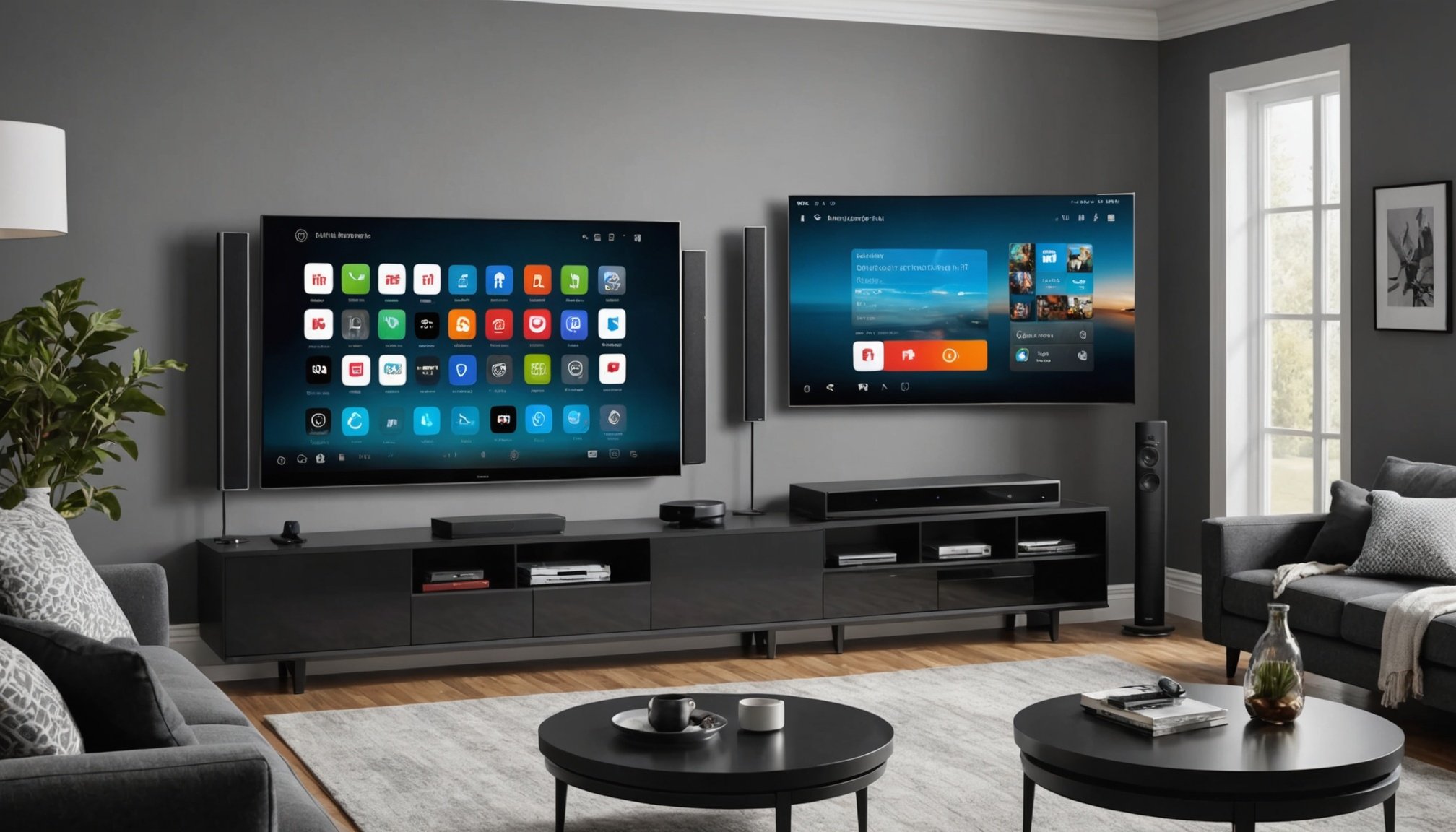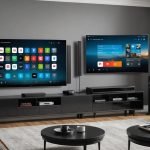Importance of Smartphones in Smart Home Entertainment
Smartphones are increasingly pivotal to smart home entertainment, acting as central control hubs. By integrating smartphones with home systems, users can seamlessly manage various entertainment devices, maximising convenience and user satisfaction. This integration allows for intuitive smartphone integration with other smart devices, enabling users to control everything from a single interface.
For many, the smartphone’s central control capabilities have become indispensable. This capability streamlines the operation of multiple systems such as smart TVs, speakers, and lighting. This reduces the need for multiple remotes or apps, essential for enhancing the overall home entertainment experience. The benefit of smartphone integration is significant, with many users appreciating the convenience and ease of control.
Also to see : Enhance energy savings: effortlessly manage and monitor your smart home window treatments using your smartphone
Additionally, smartphone integration supports advanced features like voice commands and automation, making it even easier to manage home entertainment. The satisfaction often stems from having the ability to adjust settings or switch between devices with only a few taps. This enhances user experiences and contributes to a more connected and efficient household.
In conclusion, smartphones play a crucial role in the modern smart home, offering central control capabilities that improve accessibility and enjoyability of home entertainment systems.
Essential Apps for Smart Home Entertainment Management
In the realm of smart home entertainment, certain apps stand out for their unparalleled ability to manage devices effortlessly. These top smart home apps revolutionise the way users handle streaming and device control. Apps like Roku, Amazon Alexa, and Google Home simplify the experience, offering seamless navigation and operational efficiency for managing smart TVs and other streaming devices.
A distinctive feature of these apps is their intuitive interfaces, ensuring users can switch between devices without confusion. For instance, the Roku app allows users to manage streaming channels with ease, while the Google Home app offers a comprehensive view of all connected devices, enhancing smart home entertainment. Furthermore, with Amazon Alexa, voice commands are effectively integrated, offering a hands-free approach to managing your entertainment systems.
User testimonials frequently highlight the ease of use and innovative features of these apps. Many appreciate the straightforward smartphone integration, noting how these apps streamline their central control capabilities. Users have expressed high satisfaction levels due to the swift operations and vast functionalities, making these apps indispensable in modern smart homes. Overall, these apps enhance the user’s ability to control and enjoy their home entertainment systems.
Step-by-Step Guide to Connecting Smartphones with Smart TVs
Connecting your smartphone to a smart TV can significantly enhance your smart home entertainment experience. This process not only simplifies management but also expands your ability to enjoy content on a larger screen.
Smartphone TV Connection: Techniques and Benefits
The primary methods for connecting your smartphone to a smart TV include screen mirroring and casting technology. Screen mirroring reflects your phone’s entire screen on the TV, making it perfect for presentations or sharing photos. On the other hand, casting technology, often using apps like Google Cast or Apple AirPlay, allows streaming of specific content from your phone, such as videos or music.
Step-by-Step Instructions
- Ensure Compatibility: Before connecting, check that both devices support the chosen technology.
- Initiate Connection: On your smart TV, navigate to the input/source options and select screen mirroring or the corresponding casting option.
- Connect via Smartphone: Enable the feature on your smartphone, typically found in display or connectivity settings, and select your smart TV from available devices.
Common Troubleshooting Tips
If encountering connectivity issues, ensure both devices are on the same network, update device software, or restart both devices. These steps address the majority of connection problems.
Optimizing Sound Systems Through Smartphone Integration
Modern sound systems have evolved tremendously with smartphone integration, enhancing the way we interact with music and audio in our homes. This integration boasts various features, allowing users to control their sound systems directly from their smartphones, providing unmatched convenience and flexibility.
Features of Smartphone-Connected Sound Systems
Connecting smartphones to sound systems enables wireless audio streaming, which eliminates the clutter of wires. Users can seamlessly control volume, select tracks, and even switch between audio sources through their phone. This kind of sound system control enhances the user’s experience, making it easy to enjoy music or podcasts from any room.
Wired vs. Wireless Audio Solutions
While wired solutions offer reliable connections, wireless audio provides greater freedom. Wireless systems, often connecting via Bluetooth or Wi-Fi, allow for broader functionality and placement of speakers without physical constraints. This capability is ideal for those looking to maintain a tidy environment while enjoying optimal sound quality.
Practical Tips for Achieving Optimal Sound Quality
To optimise sound quality in your home, it’s crucial to position speakers correctly and ensure the smartphone and sound system are on the same network. Regularly update software to prevent connectivity issues, and utilize apps specifically designed for smartphone speakers to customise your audio settings effectively.
Enhancing Smart Home Theater Experiences
Designing a smart home theater is about more than just choosing the right TV. It’s about creating an immersive experience with innovative technology. Central to this setup is optimising both sound and visual quality, where smartphone controls enhance user interaction. Smartphones offer convenient, centralised control, adapting to user preferences with ease. This flexibility transforms movie and gaming experiences, allowing users to enjoy more personalised setups.
Smartphone Integration in Home Theater Setup
Smartphones streamline theater setups through seamless connectivity with TVs and sound systems. Their role is crucial, serving as an interface for controlling devices remotely. Users gain direct access to features such as lighting adjustments and sound modulation; these features create an engaging, immersive experience for viewers.
Tips for Sound and Visual Integration
- Ensure your display and sound system support advanced formats like Dolby Atmos and 4K.
- Position speakers strategically to achieve optimal auditory effects.
Utilising apps specific to smart home entertainment is essential for customising settings. Music, video, and gaming apps often offer enhanced controls for tweaking parameters, such as bass levels and brightness adjustments, directly from a smartphone. Master these forms of control to elevate your home theater experience effectively.
Future Trends in Smartphone and Smart Home Integration
The evolution of technology continues to reshape how we interact with our homes, with smartphones at the forefront of this revolution. As technology advancements progress, we anticipate smartphones will gain even greater roles in smart home evolution. Future integrations may see increased automation and AI capabilities within smart home entertainment, offering more personalised and intuitive user experiences.
Incorporating machine learning could allow devices to adjust settings automatically based on user habits, enhancing convenience and efficiency. Additionally, technology advancements may include seamless connectivity across various platforms, enabling smoother interactions with appliances, lighting, and security systems. These improvements are expected to bolster user satisfaction, underscoring the importance of smartphones as an integral component in smart home entertainment systems.
Looking ahead, smart home evolution is poised for substantial growth as manufacturers focus on creating interconnected ecosystems. Such developments promise not only technical innovations but enhancements in sustainability and energy efficiency as well. Expert insights suggest that smartphones will continue to play a pivotal role, guiding forthcoming integrations and facilitating increasingly sophisticated home automation solutions, blending practicality with cutting-edge design to create truly responsive living environments.
Troubleshooting Common Issues
Connecting smartphones with smart devices can sometimes pose challenges, especially regarding connectivity issues. Common problems arise from network discrepancies, outdated software, or smartphone troubleshooting hurdles. Begin by ensuring all devices are connected to the same Wi-Fi network; mismatched networks frequently disrupt seamless integration.
Solutions and Troubleshooting Steps
- Network Consistency: Confirm that your smartphone and smart devices share the same network, as this is vital for undisturbed connection and smooth functionality.
- Software Updates: Regularly check for software updates on your smartphone and smart devices to mitigate connectivity issues. Updates often resolve existing bugs, enhancing device performance.
- Device Reset: If problems persist, try restarting both the smartphone and smart devices to refresh connections and address minor glitches.
Resources for Additional Support
Should these steps not resolve the problem, consult the user manuals or the manufacturer’s support site for more tailored smart home solutions. Online communities and forums can also offer valuable insights and troubleshooting advice from other users who’ve encountered similar issues. Leveraging these resources can significantly improve your smartphone’s connectivity with other smart home devices.











